Just thought I’d share my experience with a great product–the Nest Learning Thermostat. Given that I own an over 100-year-old house with radiator heating (and no central air), I was dubious about this working for me. After doing a fair amount of research, it came down to this one or the ecobee. The ecobee (main model) was more expensive and, frankly, just doesn’t look as good. Let’s face it; the Nest has been designed, by real designers, and it is obvious. Other thermostats on the market are clunky gear head boxes.
I have noticed that things that appear to be well designed often are. Not only that, if people go through the trouble to do great industrial design, they usually at least try to do great software design, and maybe even full on service design, and in this, the Nest does not disappoint. Everything from learning about the Nest ahead of time on their Web site to the out-of-the-box experience to the install to the setup to the ongoing usage (with apps for devices and a matching Web control site) has been designed, and designed well (and kudos to Amazon for 1-Click Prime ordering and one-day delivery–a day ahead of time).This is just one of those products where they have really pulled it off. And who’d have thunk it–for something as “simple” as a thermostat.
I used their online compatibility checker to verify that it’d work with my system. I have one of those old-fashioned Honeywell round thermostats.
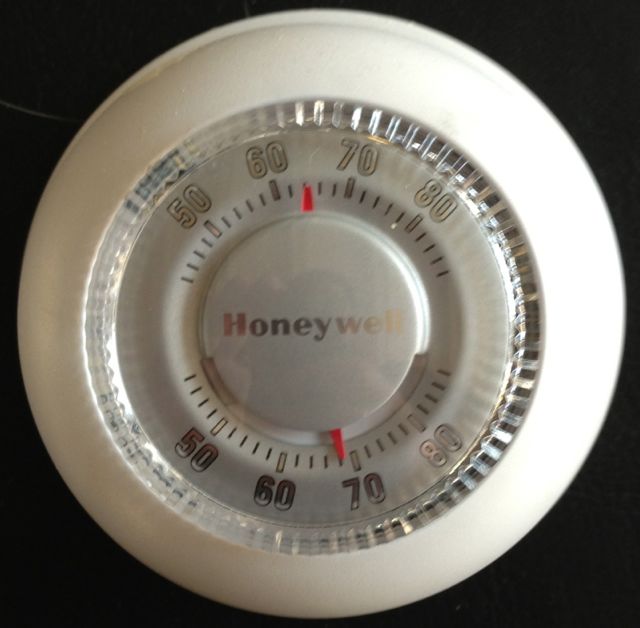
But it turned out that after popping off the front, it was a relatively new model, the Honeywell CT87K, made for heat only systems.
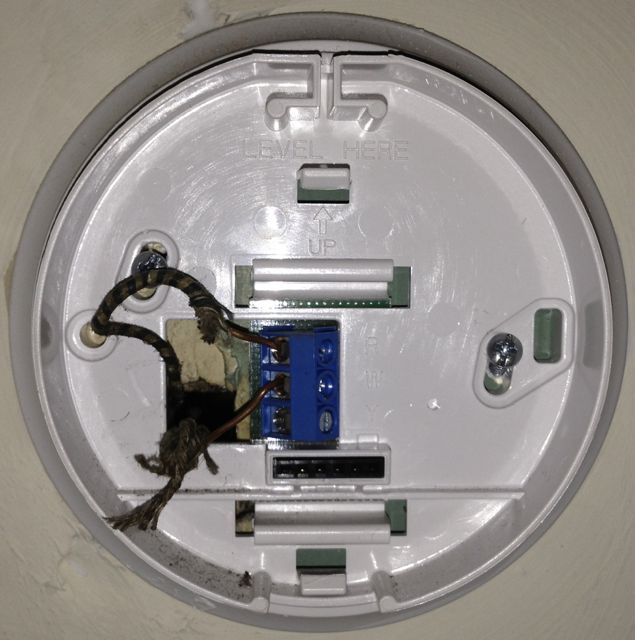
See the old wires?? Wrapped in like cloth or something. I told you it was an old house. 🙂 Anyways, zooming in I was able to see the R and W letters by the wires, so I could plug that into the compatibility checker, and voila, they said it was good, and they even give you a wiring diagram up front to show how you’ll hook it up. Pretty snazzy!
I thought I’d give it a whirl, and so I clicked the little 1-Click button, and a day later (two days, ahead of time, thanks to Thanksgiving), it shows up. (Even the box is kinda cute.)
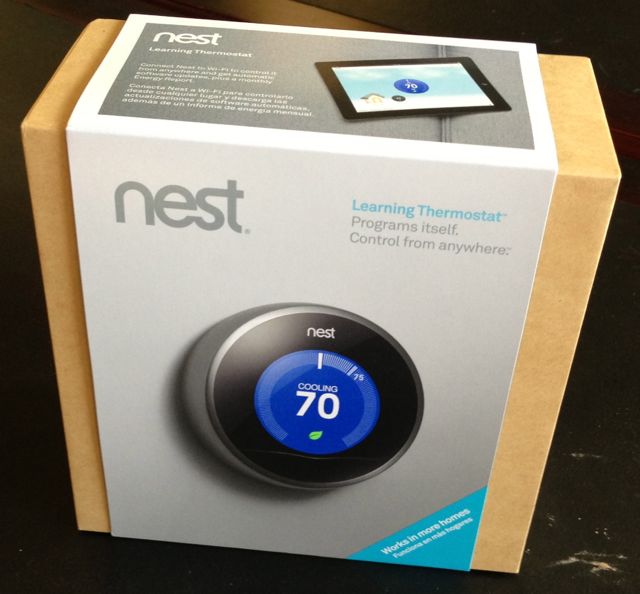
You take off the plastic wrap, slit the tape holding it shut, slide off the cover, and open up.

Lift out the Nest (has a little plastic circle on it), lift off the first layer, you see the booklet, lift that out, and you have the next layer of goodies.
You see their chubby little screwdriver, the Nest back, and two mounting screws. Slide out the booklets; there are three.
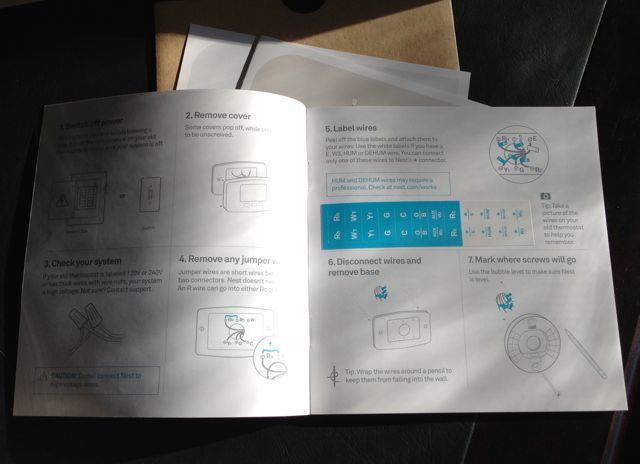
You have the install guide, the setup guide, and a “concierge” card (if you need to bail on a self install, a nice security blanket). What you see above is the first page, that tells you high level steps for uninstalling your old thermostat. What’s cool about it is the built-in stickers to label your current wires as you take them out. Given the variety of systems out there, and no standardization on colors, this is the only way to do it. So be careful! For me, of course, it was simple–two wires. But I labeled them anyway!
BEFORE MOVING ON, CUT THE POWER TO YOUR THERMOSTAT. For me, the thermostat wires come from the boiler, so the circuit to break was the boiler’s circuit. I verified this using my handy dandy Greenlee GT-16 Adjustable Non-Contact Voltage Detector, which I bought some time ago for other amateur electrician work on this old house. I can detect voltage in the air on the max sensitivity, so what I usually do is check it before trying to disconnect. Dial it back until it detects only when you’re near the hot wire. BTW, don’t take my word for it–I am not an electrician; YMMV.

Now that you’ve cut power, you can label the wires safely.
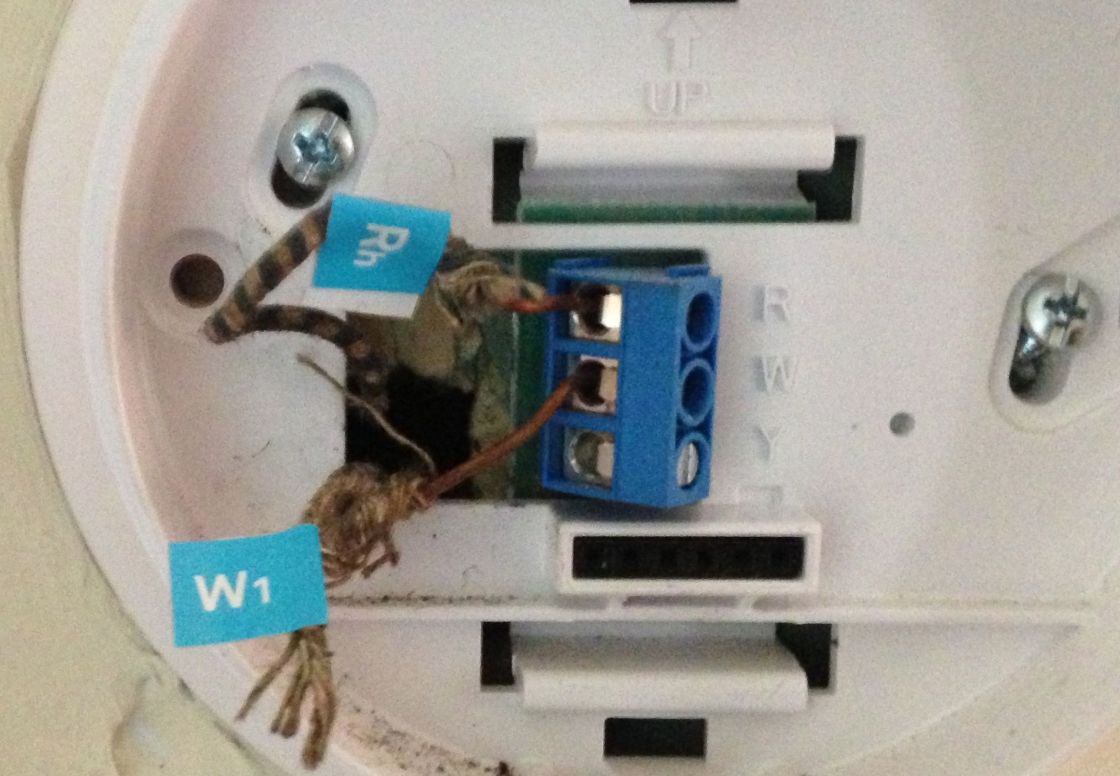
Even though the old plugs only say R and W, Rh and W1 were the only/closest option, and it matched the wiring diagram from the compat checker.
Now, niftily enough, the screwdriver they include has a small enough head on it to reach in those holes on the right and unscrew (loosen) the wire clamps. Simply pull them out at that point. I cheated and used my drill to quickly remove the two screws holding it onto the wall. I carefully pulled it off the wall at that point, to avoid ripping any extra paint off (the painters got mighty close to it). It revealed the green wall beneath the new cream paint. Here’s the whole old thermostat.
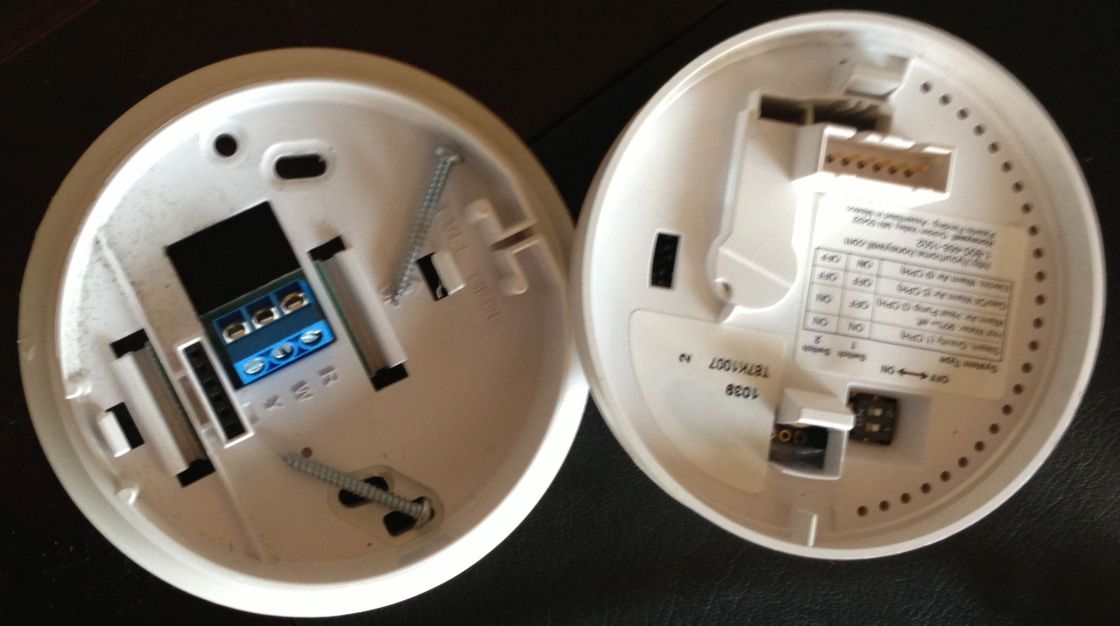
It probably took you more time to read this than it did to get the old one off. Now for the install. I walked the Nest’s back over and looked at where it would install. The hole is in the center on the Nest; on the old one you can see it was to the left. Bottom line, this meant I couldn’t cover up the old green with just the nest, and since I didn’t have any putty or paint handy, it was back to the Nest box for the decorative backing plate. Lift up the last layer in the box to reveal the backing choices; they have an option to mount on electrical boxes as well. I just needed the pretty plate to cover the ugly wall stuff.
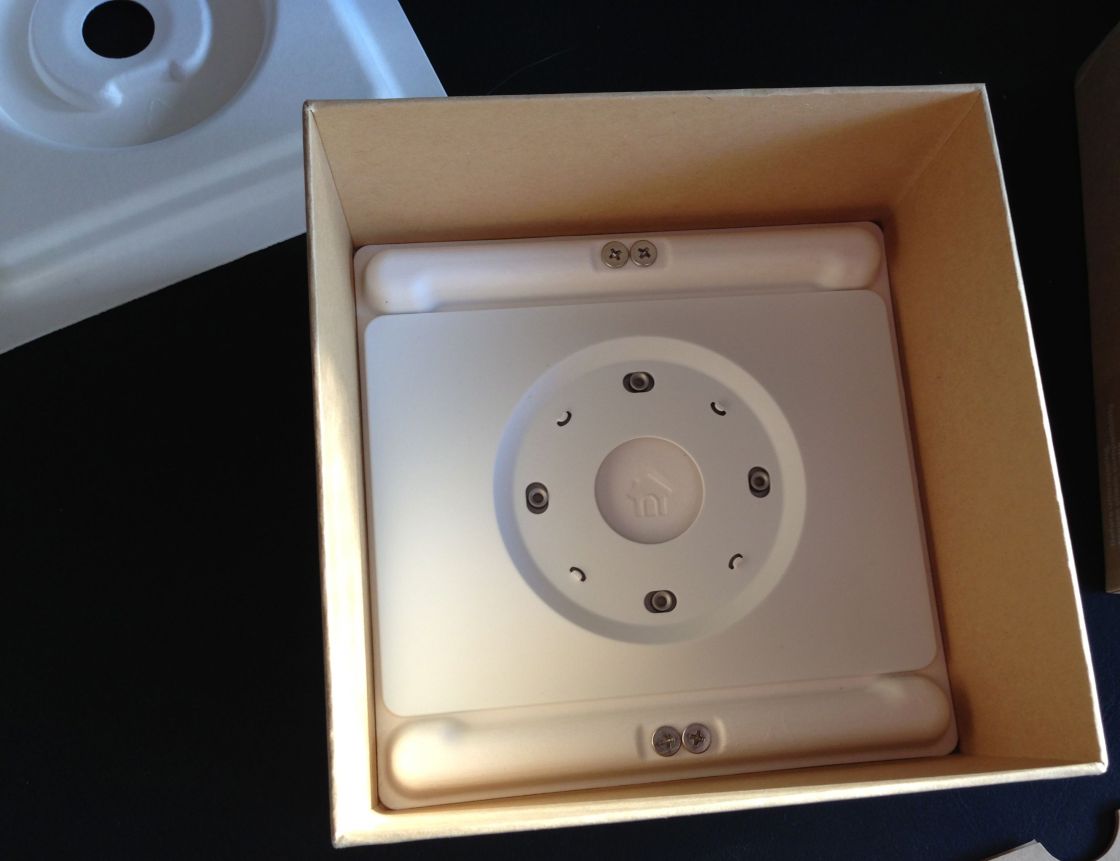
Again, I cheated with my cordless drill (Makita 18V Lithium Ion, BTW, if you need a recommendation). Would be more annoying (not impossible) to use their included screwdriver.

Now, I used my old, somewhat crappy level to install this. It didn’t quite come out straight, as you can see. Then I noticed the built-in level, and also, the screw holes have a little play, so I loosened the bottom one and realigned using their level. Hey, look, it also aligned with the nearby wall edge at that point, too!
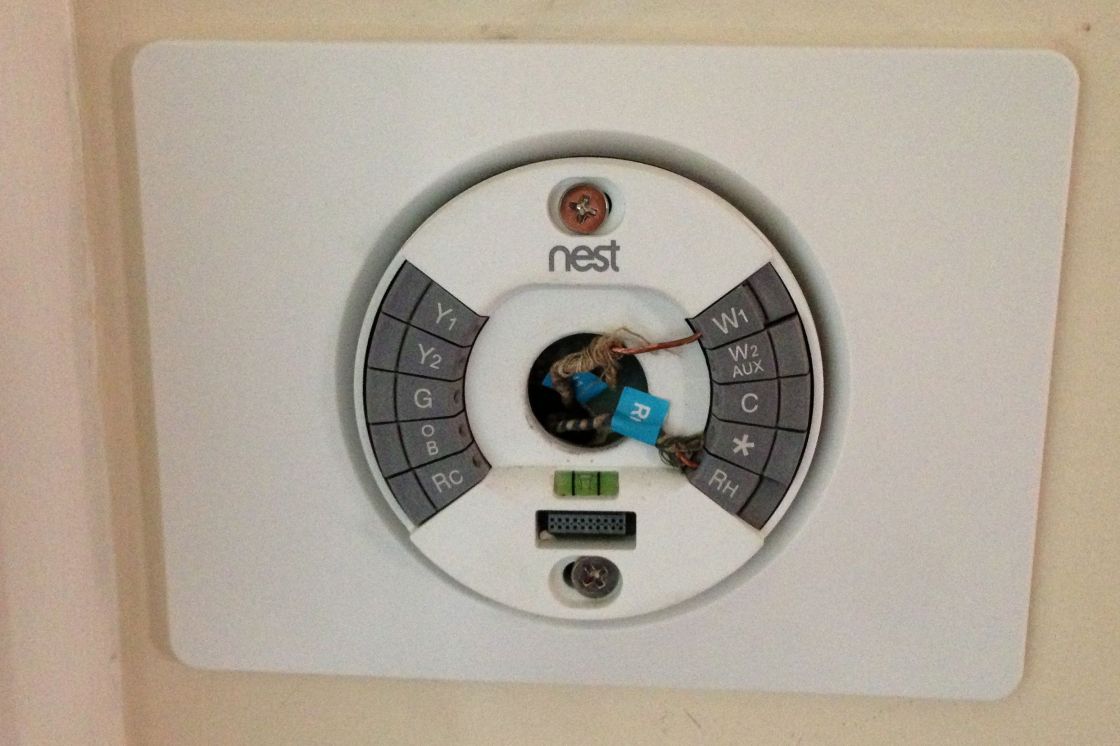
Oh yeah, I plugged in the two wires into the matching slots. One of the cooler but maybe non-obvious features of Nest is that it runs fine on your 24VAC line. Many new/digital thermostats require a “common” lead that provides dedicated power. Not so with Nest–no extra wiring needed. Even my ancient two-wire system works fine with it! Just use their compat checker to verify yours.
My wires are tough (they were made back when men were men, wires were wires, and little furry creatures from Alpha Centauri were little furry creatures from Alpha Centauri); they are not huge but not thin either, so I used needle nose pliers to straighten them. A more obsessive person may have grabbed some electrical tape to cover up more of the exposed wire. Me? I don’t sweat the small stuff. It will soon be covered up. We’re almost there! Next step, grab the pretty Nest and plug it on.
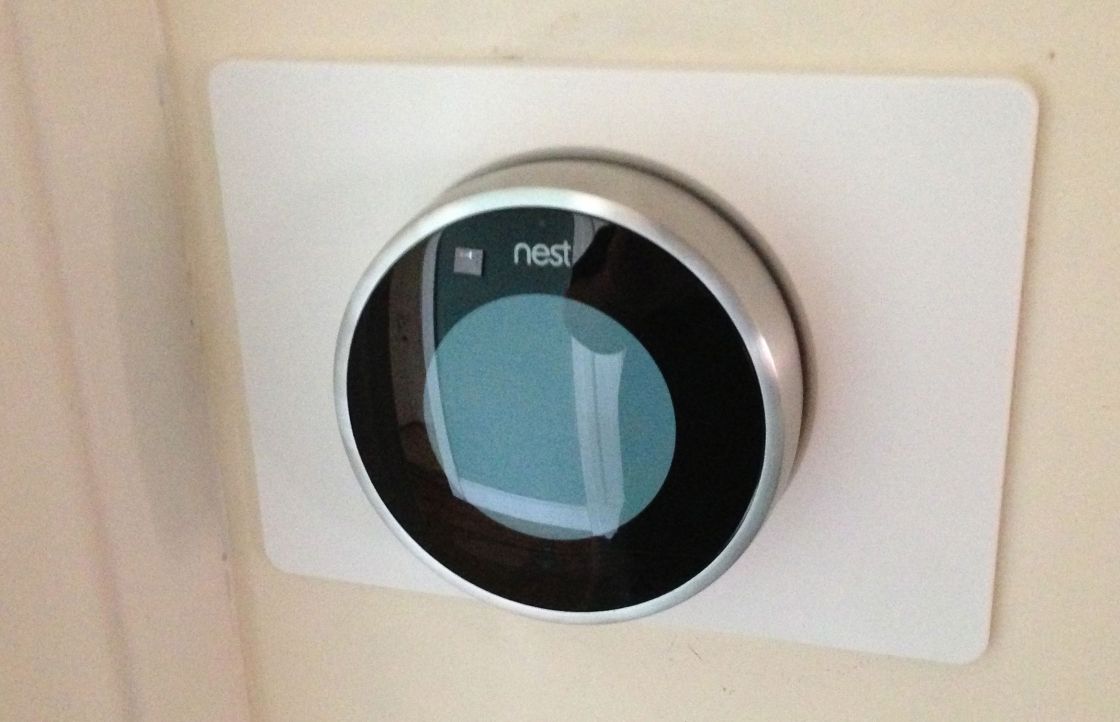
NOW, you can go flip the switch back on. My breaker box is in the basement, but no worries, when I came back up, it was waiting for me. Time to setup. You say “Hi” to it, and confirm your language, then on to the coolest part of the gadget–it is Wifi connected. Seems to have a decent antenna, too.

I also thought the interface for entering the password is cool. The Nest slides so smoothly. Feels solid, and dialing it to enter the password was strangely reminiscent of using a rotary phone. (Yes, I remember using them, although they were definitely on their way out by that time.) Hello, nostalgia. And it wasn’t that hard either. They seem to have put thought into how fast you turn, inertia, and that sort of thing. Nice.

After a short connecting message, it confirms, we have lift off!
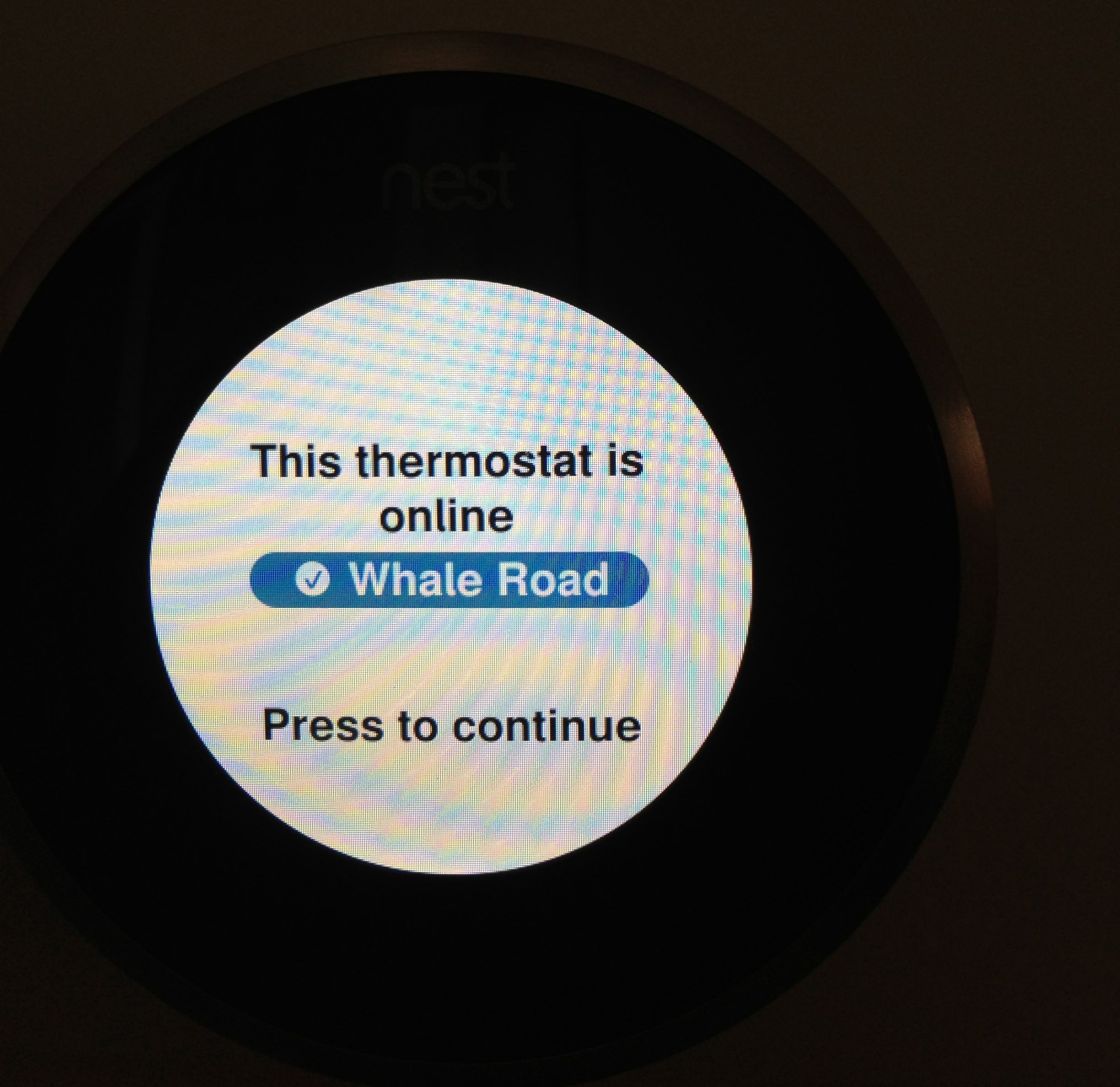
Just a few more steps.

BTW, I glanced through the setup manual. It is super thin and easy to follow. You don’t really need it though at this point–just follow the prompts. After confirming I only have heating installed, it just needs to ask a few questions about it.

(For the record, I have oil. sigh. Maybe someday it’ll be different.)
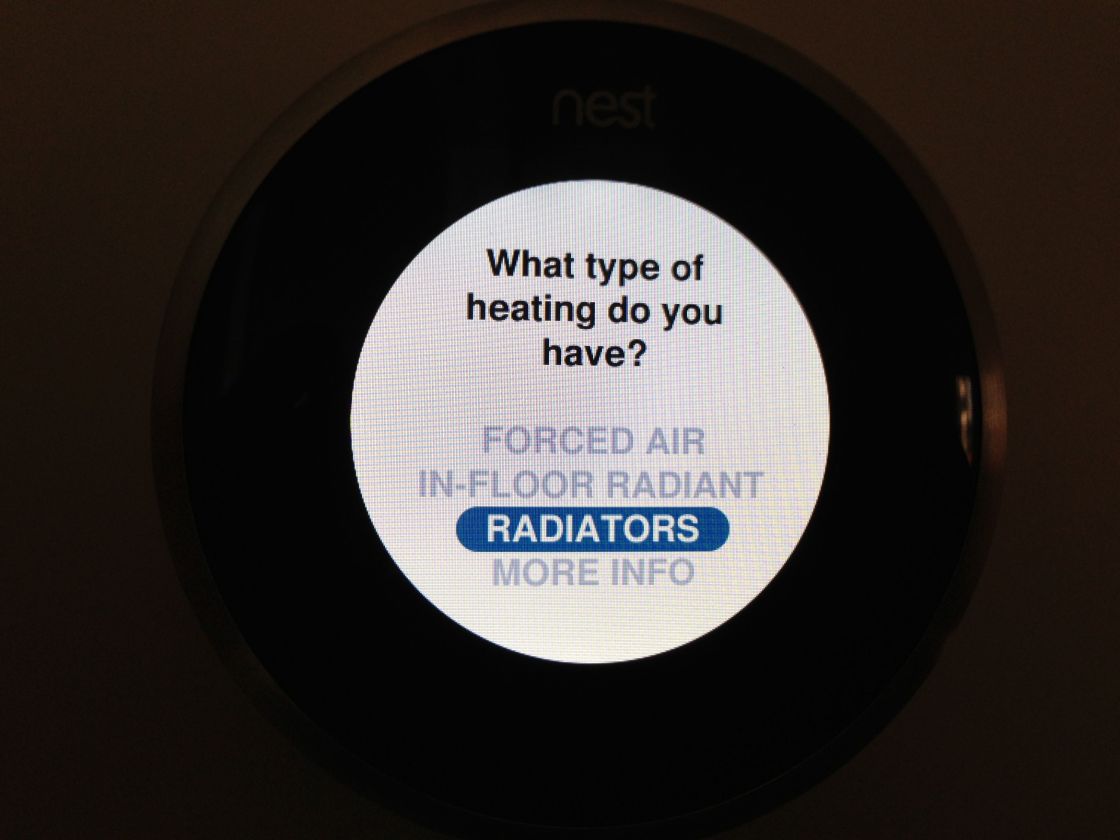
Radiators, yup. That’s us. I had NEVER seen them in person before I moved up here to NJ. But I like them a lot better than forced air, I have to say. I like the feeling of the warm, radiant heat. When you keep the house cool-ish like we do, forced air sometimes feels more like air conditioning than heating–blowing around 66 degree air. Radiators always feel warm, reminding one of a fire. (And I love fires!)
A few more questions–zip code and number of thermostats. Now I get to my favorite question. When was this house built?

What? No 1910s? Come on!
Next up, naming this Nest; wish I could do a custom name, but they just have some preset to pick from. Ah well. Can’t have everything!
Last, it asks a couple simple questions about temps and lets you know it’ll try to learn/calibrate for some time. And.. we’re done!

As before, it likely took you longer to read my account than it will to set your Nest up in real time. In fact, I bet Nest is annoyed with me because this may make it seem more complicated than it is. 🙂 Really, we’re talking <30 min end to end, and it felt great and easy!
At this point, I was pretty pumped, because I wanted to go control it from my phone. But first, to the Web site. I quickly signed up, and it detected the nest on the network. Too cool! I walked over to it again, and it said this.
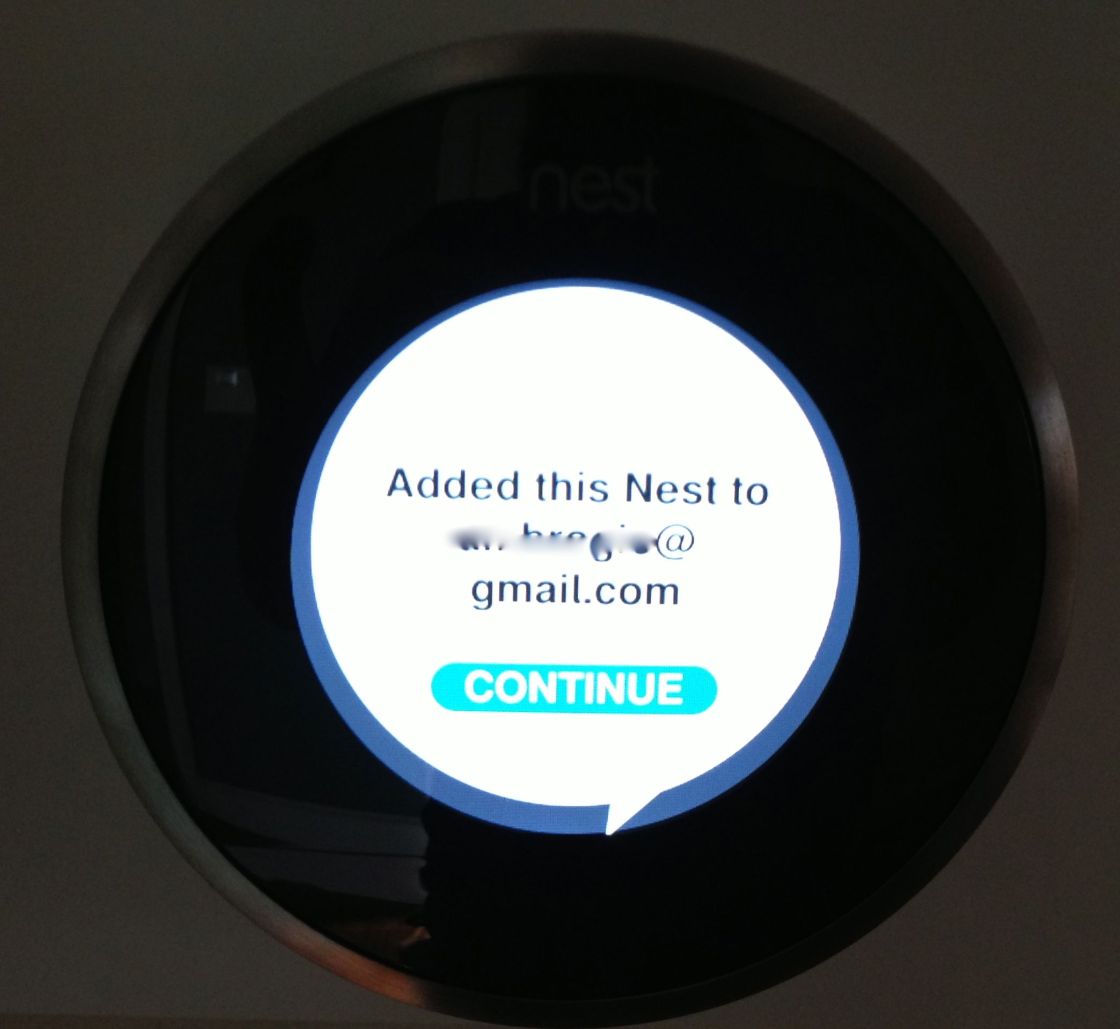
Too cool! In no time, I was managing my thermostat remotely. THE POWER!!!
And the app is nifty. It seems to gradually reveal complexity (another great UX principle). Just tonight I discovered some new things that weren’t there before. Still, it is quite simple and pleasing. I like how it incorporates local conditions in the background. For instance, now it’s like so.
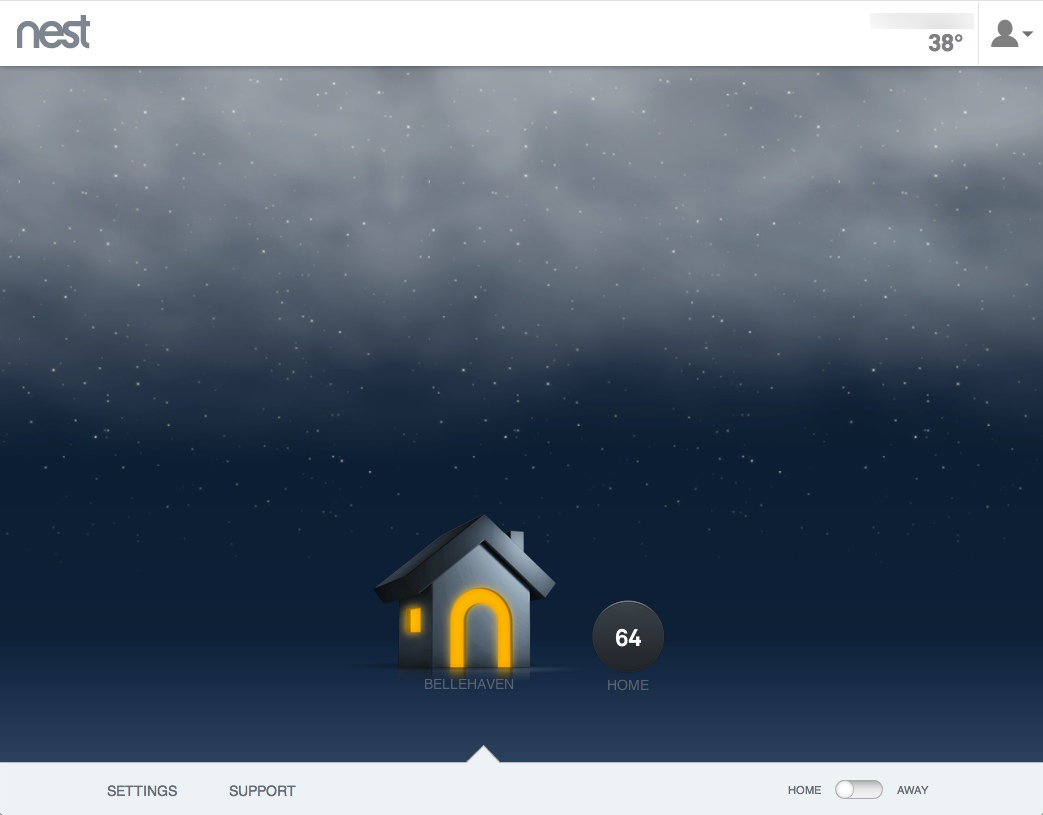
I won’t bore you (more) with all the settings and stuff. The interface is quite nice and, in my estimation, easy to learn and use. And hey! Will you look at that!? I guess you can have everything–it let me rename my thermostat here.
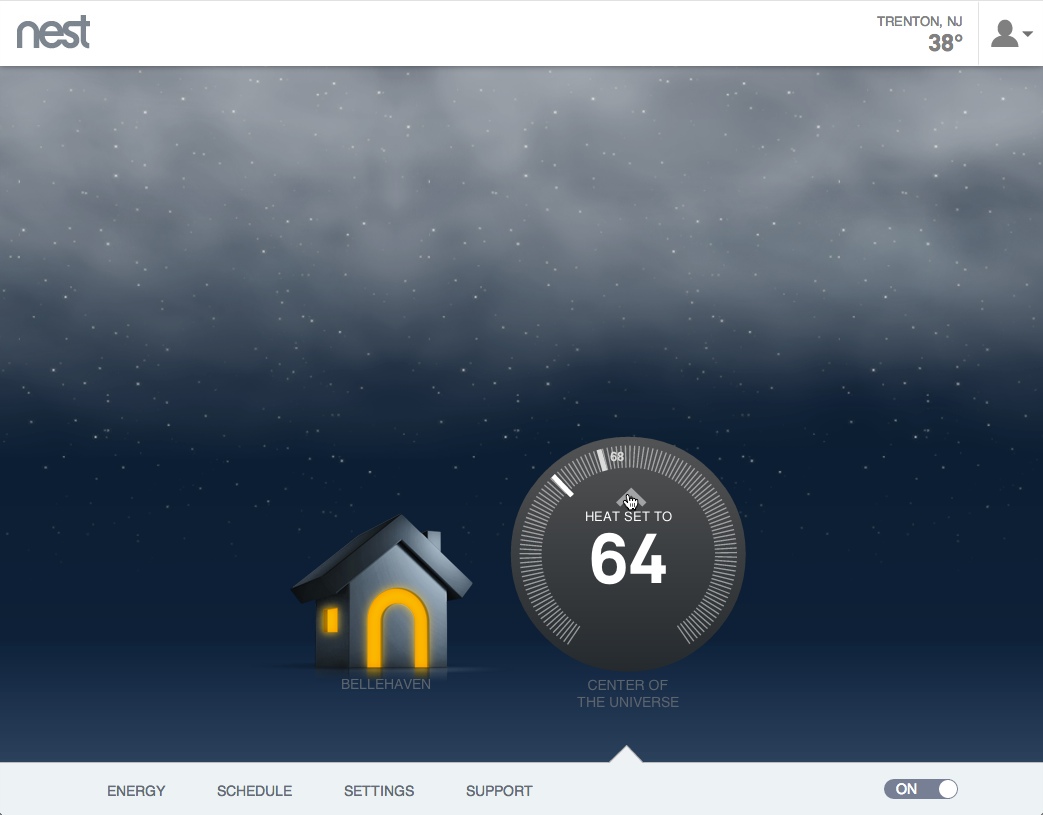
Note that when you hover over it, you can simply click the up arrow or down arrow to increase/decrease your thermostat setting. You get the same basic interface on the phone and tablet (I use iPhone and iPad, FTR). There of course they smartly don’t rely on hover to see the up/down arrows. 😉
I am a little obsessive. Sometimes. About some things. I try to fight it, but it gets me sometimes. I quickly set up a schedule (even though it wants to learn it by you turning it up and down). I mean, I don’t want to run downstairs in the morning to turn the heat up–I want it done for me! This is a minor criticism, but I guess it works for “most” people who wouldn’t otherwise set up the schedule.
In the Web interface, this is easy enough. Add a setting, then copy and paste it to the other days. OMG. Like, I programmed the three thermostats at my last place, and what a friggin pain! No wonder they say 90% of people don’t do it. I dreaded changing the temps, too, cuz it meant clicking and switching through about 100 fiddly switches. This took me 30 sec. Wow.
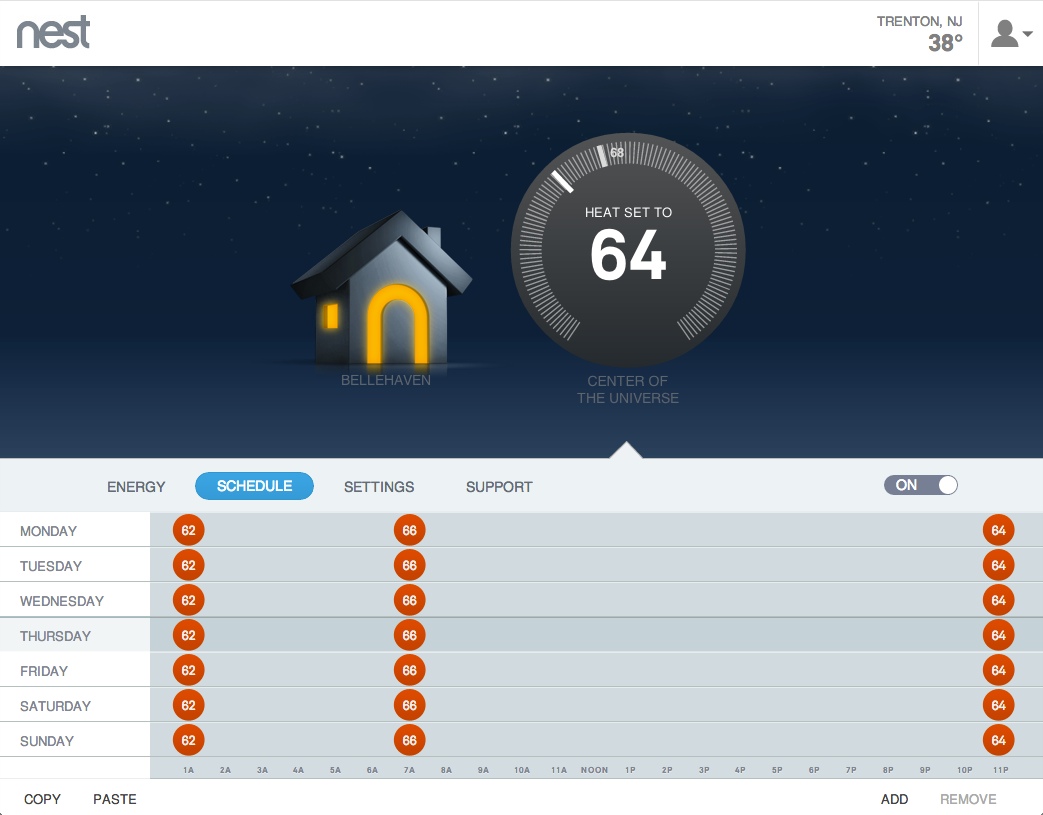
And yesterday, I discovered my new favorite feature–the energy records. I can see my obsession will not soon end.

You can selectively drill into daily details to see just when Nest was powering on that monster of a furnace against your schedule for the day. I think I’m in geek-homeowner love!
Now, time will tell if this does help me save money. I can’t see how it won’t. I mean, last winter (our first in this old house), I just left it on a constant 66-7ish setting on the dial, more or less. If nothing else, being able to have it turn down during the evenings should save a good chunk of change. And considering how much this old house costs me per month to heat, trust me, in like two months it will probably pay for itself.
So that brings us to the final consideration. Is the Nest worth $250? Well, from the research I did, learning thermostats can save 10-15% on average. You can do the math based on your usage. But that’s just part of the story. This is one grand toy, after all, no? 🙂 So a great toy that can save you money? Is it worth it? I think so.
If you’re on the fence, I strongly suggest going for it. It’s awesome. Go order the thing, yo! (Don’t forget to check your compatibility first.)
P.S. Nest didn’t pay me for this review. I’m just totally psyched about it. It took probably 6x the time to put together than installing it took. (Don’t worry–I was watching Burn Notice in the background with the wifey for most of it.) But if you use my links to buy, I might get some small Amazon affiliate commission. So that’d be a nice thing if you found this helpful.

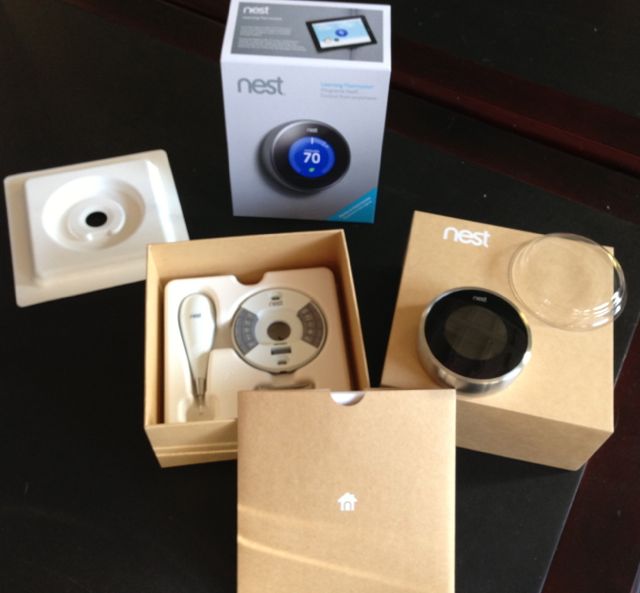

So I’m in a situation similar to yours. Cold climate (Minnesota) with radiators in an old house. No central air conditioning. I’m wondering whether or not the Nest will save us enough to make it worth it to buy. (I’m pretty much on board, but have to justify it against other costs. We’d need two Nests for our house.)
Now that you’ve had it for a few months, can you tell whether you’ve saved any $$ in your heating expenses?
It’s hard to say how much we’re saving at this point. We have oil, and it is a colder winter. I think I’ll better be able to guess at the end of the winter and can compare and try to do some accounting for temps. Anyways, I think it’s totally worth it for the convenience and the smartness (how it adapts and minimizes overshooting with radiators).
I’m also trying (now) comparing between doing a setback at night and keeping it constant. Doing comparative energy usage with it is easier than comparing to prior cuz they have the nifty usage logs.
BTW, if you leave a lot for extended periods of time, that can be another definite plus on this one–the auto away thing. Problem is that some of us are almost always here, so that doesn’t help us. 🙂
Thanks. I’ve yet to really come across any accurate data from users out in the real world about savings. Plus I suspect it would be hard to find data that accounts for gas heating only (i.e., no cooling savings in the summer) and/or radiator heat. So I was hoping you might have data that would lead me in the right direction.
We have people in and out of our house all day, so I don’t know if the auto-away will help too much – especially with radiator heating. We’ve got programmable thermostats and we lower some at night, but perhaps the Nest will still save us some money. I’m not looking for immediate payback, but if it’s only going to save me $5/month in the heating season, I don’t know if it’s worth it or not!
In any event, I’m glad you like yours. Thanks again for replying.
I just installed one!!!!
What about dogs? Do they cancel out my being away?
And I don’t have a thermostat upstairs.
I think it’s supposed to be smart enough to tell the difference between people and animals. But you’ll be able to tell based on history after a bit.
Thanks so much for your detailed how-to guide. I too have a 100+ year-old house with vintage radiators, no central a/c, an oldie thermostat and cloth wires here and there. I needed to know if those facts alone meant no Nest for me. Will now try the compatibility check. Thanks again.
so how much you saved the past winter? thanks!
Overall spend was roughly the same, but according to the Weather Underground history tool(http://www.wunderground.com/history/airport/KTTN/2012/10/1/CustomHistory.html), this winter was noticeable colder than the prior winter. I used Oct 1 to June 1, comparing 2011-12 to 2012-13. For 13, average ranged 39-54F with 19 avg heating days. For 11-12, it was 41-60F with 15 avg heating days. I also have to account for cost of fuel, which increased. So I have more math to do, but I feel pretty confident saying that it is saving a chunk of change for us.
Beyond money, I have really liked is being able to see and control it remotely, and the auto-away thing made going on vacation simpler. So convenience is also a factor.
I did try different approaches–letting it get colder at night and heat back up versus not so cold at night (62 vs 64). I don’t think that made a huge difference judging by watching the energy used–the heat lost needed to be replaced in the morning–so the longer you can keep it lower, the better trade off this will be. It does a pretty good job of not overshooting, which is a common issue with radiators and using setbacks. I think it would be even handier for families who are all out during the day as well–the auto away feature works well for that.
HTH.
We have had our NEST thermostats for nearly two years, and LOVE them. Also, being able to control my home thermostat from my iPhone is awesome when I travel so I can be sure I didn’t accidentally forget to set it to AWAY. Additionally, my home has two heating/cooling zones and the NEST manages them perfectly.
Reblogged this on Home Renocation and commented:
Hey! Someone else with a 100+ year old house with radiators using a Nest! I’m strongly considering them for my house. Being able to see/adjust the house temp before I leave work so it’s toasty when I get home? Yes please!
Hi Ambrose,
It looks like I have the exact same boiler/radiator/oil setup (and home age) as you. I took off the thermostat to do the NEST install and only saw the two wires and assumed they were high voltage/line wires. Which NEST says is not compatible, so I didn’t proceed with trying the install. But they look just like your old “cloth” wires. Did you do any kind of low voltage conversion off of your boiler? I have a separate A/C unit on the roof w/NEST and I like it a lot, so I’m hoping to get this running for our heat.
Hi Tim, I did not do anything special with the wiring. They recently updated (two years ago) the boiler, but I have no idea if they changed the voltage of the wiring. I think it’s safe to assume if you have a regular old fashioned thermostat connected that it is 24v, but you can get a volt meter to check if you are worried.
Actually, come to think of it, I think I looked on the boiler and it said 24v on it somewhere near the wiring, but don’t quote me on that. If you can look up your boiler, it will probably say.
It worked like a charm!! I had actually scheduled an electrician to come to my house next week, but figured I’d give it a go. I just wanted to thank you for this blog post and wish I had seen it earlier as this was a project I set aside from the spring. If you are ever in DC let me know and I’ll but you a beer(s). Thanks again!
Great! Glad to hear it!
Amborse Little, do you have any issues with the battery dying due to your system not having a C-wire? I also have a 2 wire ( RH and W) system, and i keep reading bad experiences where the NEST keeps cycling the boiler due to low battery, and low usage of the heating system…did you experience this during the summer months?
No. I just turned it off during the off season. I think it came on one time mysteriously (maybe a system update), but I just turned it back off.
you mean you completely turned off the NEST? or you just turned off the heat request to boiler and let the NEST idle.. Thanks, I so want this thermostat…but i dont want to be left in the cold this winter…
I left the boiler/power to the boiler and thermostat on. I used the On/Off switch in the Nest app to turn it off. It still had power but was just in the Off state. When you walk by it, it says the temp and “Off” on it when it is off.
Thanks you so much! now off to Lowes to get it!
No prob. Enjoy!
Thanks for this review – I found it very helpful as I also have an old house with a 2 wire system and radiators. I ordered my Nest – the great thing is, my gas company gives a $100 rebate, so it only costs us $100!
Hi, Do you think it can be used outside the US ? It asked you for a ZIP code. Can it handle being used in Europe ?
Nest Supported Counties
Thank you SO VERY MUCH!!!! for this, my house was built in 1868, and I too have radiators, no central air, and an old Honeywell thermostat….because of your detailed and I do mean Awesomely Detailed product “review”, I will be purchasing this system in a couple of days…..just had to tell you Thank you!!!!
Glad it helped!
Ambrose Little – Thanks so much for your detailed post. I’m very much in the same boat as everyone else – house built in 1915, radiant heat, separate AC system. I have 3 cloth covered wires in my current thermostat but only 2 are plugged in. I did the compatibility test on the 2 wires using the Nest website and it says that it should work. I am very interested in purchasing it but am also torn about it.
I have several friends who have them and completely LOVE them. I also know a couple of HVAC professionals who have had to support them and they say to stay away from them. One told me a story of a customer who had one installed during the recent polar vortex and the Nest wasn’t receiving enough power and it just shut off and wouldn’t turn back on. On the Amazon page there also seems to be lots of horror stories about freezing pipes and people arriving home to 85˚ houses due to failing Nests.
Since it’s been awhile after you posted this I just wanted to check and see if you’ve had any issues with yours, specifically with it losing power and shutting off or with it going rogue and making your house a sweat box. Thanks again!
Of course I can’t guarantee it’ll work perfectly for you..
I had one odd behavior way back when I first bought it–cranked the heat up pretty high for reasons unknown to me.
About power, your heat won’t work if you don’t have power–the boiler needs it. At least that’s how mine works, so blaming the nest for not working in that situation doesn’t make sense to me. If the boiler has power, so should the Nest, as I understand it. Even professionals can be mistaken and blame the wrong thing because they honestly don’t know what is wrong, especially when they may be old timers who are faced with new tech that they don’t understand. 🙂
I turned off the self-learning and just set a schedule for mine. It works fine. I love the user interfaces and the fact I can check/set things on my laptop, phone, and tablet. I am happy with my purchase.
Although the aesthetics and technology of the Nest are intriguing I wouldn’t expect much in energy savings. If anything you may experience the contrary. I work at an HVAC wholesaler and many of my colleagues are technical experts who have many years of experience. They all recommend setting a temperature and leaving it when it comes to steam boilers. Nightly setbacks can actually become more costly because of the heat loss and energy it takes the boiler to get back to temperature. Remember, this isn’t a furnace that simply fires and spins a blower wheel to move heat. A boiler has to heat the water until it changes states from liquid to gas (steam). This takes an enormous amount of energy, which offsets any savings you would expect when the boiler isn’t firing. If you’re buying it for looks and the connectivity that’s fine, but I would temper expectations if you think you’re going to save a lot of money. You may be better off just keeping it at a set temperature. If you don’t trust me you can Google “programmable thermostats with steam boilers” or “nightly set back with steam boilers”.
I have read a good bit. Those that dispute tend to say it is more or less equivalent which makes sense given that heat is heat and heat loss is heat loss. You have to set back for long enough or low enough for it to make a diff.
That’s very true John, that’s why the Nest developed new algorithms where it slowly works to reach a scheduled temperature rise.
Wow, chapeau for taking the time to figure that out! I have a similar problem, but found this alternative for radiators: http://istabai.com it’s pretty nice looking 🙂
Thanks for the posting. I am about to install a Nest next week, in my old New England apartment with steam radiators and no c wire. I was wondering if you have enough data points now to definitively say you see savings. Also what is your nightly setback during the winter? Thanks.
No, I’m not sure I can confirm there are savings for us. We homeschool and so are virtually always home. If you do a setback, it seems it has to be for an extended period of time and even so, it takes more energy to get things back up to temp. The savings will come if that equation works out for you: you get setback for long enough periods of time to offset the costs of bringing things back to temp. And because there are so many variables, including weather, it is really hard to calculate without more control.
Still, I like the Nest. It is very convenient to be able to adjust remotely, and if you do leave, the auto-away feature is pretty nifty. I also like being able to lock it so if the little kids mess with it, it won’t get too out of whack. I did not use/try the auto-learning feature, but I think that’s another thing a lot of people like.
Thank you for the walk through! This gave us a lot of reassurance about installing in our 160 year old home!
Thanks for writing this up. In a very similar situation (101 year old home) with a gas boiler, heating and moving water about to house to our beautiful radiators.
I had exactly the same two wires (heat + power) and the nest install and experience you described made to go for it. Installed last night in 20 min. using this page.
thanks!
Thanks for the great review!. I have a 103 year old house, and was wondering what to do with only 2 wires. My living room looks complete now.
thanks for the post. I have been going around and around with nest support. I have a 2wire boiler with radiant heat that I use in the winter, and a forced hot air I use in the summer. I am wiring both systems to one nest since I only use one system at a time. Your wiring helped me figure out that my G/T wire on the boiler should go to the nest W. I’m going to give it a go next weekend. Thanks again.
I live in a relatively new house with gas and bought a Nest only for the downstairs. Supposedly the heat pump upstairs shouldn’t really swing in dramatic temperature changes so we keep that constant as we also homeschool and are at home most of the day. The Nest downstairs is a different story and that is fully programmed. I didn’t even need the manual as it is just click and spin. We are looking at an old house circa 1900 with radiator heat. The heating bills are nearly three times as much as our present house. We have our last appointment with the realtor before putting in a bid and my mission in seeing the house one last time is specifically centered on Nest and thermostats. So if you want to know my confidence level as to whether Nest will save you money the deciding factor on whether or not we move to an older home depends on whether a Nest thermostat will ease the pain of heating. Thanks for the blog. As you can see your time spent could make a big difference.
Hey there,
Just installed nest in my 205 year old house! Easy hook up and all that but I have a question for you now that you have had yours a while. Do you actually save money on fuel costs? I ask because in the week I have had the nmest I have noticed my boiler (oil pushing hot water to radiators) fires a LOT more often trying to keep the room within a degree or whatever of the setting. With my old Honeywell Mercury measured one it would fire like once every hour to hour and a half, granted the temps would swing by + or – 4 degrees, and the nest fires it about every 30 minutes. Just wondering if I am burning a bunch of oil to heat up the water, push it up into the house, and warm the house one degree vs it going less often and just pushing hot water a little longer once it’s already fired up and going.
Would love your thoughts!
It takes some time to learn your setup. Be sure you set the right kind of heating. Also, it can duel with newer boilers. When we upgraded they had to install extra bits on the boiler so they play nice together.
I also find that it takes longer to hear the house. I have a steam boiler and it’ll fire run for 7 minutes shut off and fire up again 3-4 min later. With a steam system the furnace need to run for a good 15-20minutes to get steam to all the radiators. So with a 3 floor house And really cold temps the nest can’t keep up. I’m going to keep a backup Honeywell dial thermo for those days which totally defeated the purpose.
So what happens when the power goes out or if you loose the wifi for some other reason? I’m a little afraid after this winters articles and all of Nest’s insane arbitration rules that having the house warm when we get there in below 0 weather isn’t worth the risk of having the heat turn off in the same weather and having all the pipes burst in an 100 year old house while I’m away!
My folks just got a Sensi after being scared off by the recent Nest press and are completely in love with it but have an additional land line alarm that goes off if the power goes out while they’re gone and a neighbor who can go check in. I have neither the additional alarm nor the helpful neighbor and and I love the idea that I can link with IFTTT and have the heat set for higher when the temp is supposed to be below a certain degree.
Thoughts on power/ wifi failures?
Well, most boilers won’t work without power. And the Nest keeps working without wifi, and it has a battery backup. So you have to be without power for a while.
I don’t think you’re in a much better or worse situation with a Nest versus other options in those conditions. But YMMV.
Hey there Ambrose, I have read your article and excited about changing to Nest. I have a 1920’s old tudor with the same two wires issue. I’ve took out the plate of my old Honeywell and unfortunately it doesn’t have any labels or marking like yours (no R or W). Should I just go for it?
I am not an electrician, so I couldn’t say yes to that. I’d recommend contacting Nest support. They seem to be very responsive and will likely know better than I.
Nest said no!! But I saw your pics, diagrams, and with a little bit of luck. It was succesful with a little bit of hiccups. Thank you so much. I’m now a proud owner of 3rd Gen Nest.
I am trying to install this in my house and i have steam heat radiators with gas boiler but is saying no power. I contacted next and they say its not getting enough power. How did you get it to work ?
As I recall, you have to have a power line to it. Been too long for me to remember the details.
Hi, I have a Nest w/Gas boiler (hot water, not steam) and two wires – the Rh (power) and W1 (heat), and it has worked flawlessly for about 3 years now.
If your Nest isn’t getting enough power, perhaps there is something wrong with your Rh wire/power wire – not enough voltage on that wire. Although the requirements seem fairly low.
So I talked to NEST on the phone today. I have the exact same old boiler set up as you do. They told me that the NEST absolutely would NOT work with only 2 wires and thereby the end of a month or so the NEST battery would totally die and I would be without a thermostat? They said the only way to recharge the battery is by using an Android phone cable plugged in for about an hour every 2 to 3 months with a 2 wire only set up? I am so confused?
https://nest.com/support/thermostat/
I put in my two wires (R & W) today on their compatibility checker, and it said all generations are compatible. Not sure whom you were talking to, but it sounds like they don’t even know how to use their own compatibility checker.
Thank you so much for your post. I have a 90 year old house with same wiring. The “nest pro” came over and said that I would need a C wire ($400+ extra) and they would need to drill holes, etc. But I went to Nest Support and they said I don’t need it and started researching and found your post. You just saved me $400! Thanks so much!!!
greetings….i have a similar setup…boiler, radiators, no central a/c. i’m looking at nest, ecobee and honeywell. Do you, or anyone here believe the remote sensors the ecobee3 has would benefit an old system like this. I wouldn’t think so, as the steam goes through the pipes and hits the radiator, i can’t imagine how it would direct more towards a section of the house that is colder than another.
I’m looking at the ecobee lite and honeywell lyrica thermostat which are about $150.
Are they controlled by cell phone when we are away
Yes if you use the app or web site
I just had to leave this reply. I am a foreigner (in the process of green card), 28 year old woman, first time home buyer, just bought a 79 year old home. So I almost know nothing about home.. and wanted to get z-wave-able thermostat because I chose my alarm system as Abode. My house doesn’t have a central a/c and I know I have radiators but did not know what heating system this was (still don’t know if this is electric or gas.. probably gas). Then I came across your post, which has almost same Honeywell thermostat (mine’s a bit older because it doesn’t even have labels for the wires)! So I got Nest Thermostat E (just because it is cheaper). My wires weren’t labeled but colored green and red so I tried to put them in G and R but of course nothing happens. I looked up and it says red goes to R and blue goes to W. Hoping that blue is green, I tried, and it perfectly works!!! So I am so happy and wanted to thank you so much. Hope you’re enjoying Nest and your home!
Thank you very much for this article. Even 6 years later, it’s still relevant. I too have a 100 year old home in NJ, steam boiler with radiators, and 2 wires. I just installed a Nest gen 3 yesterday + an additional temperature sensor and while it didn’t work at first, the fix was to just flip the wires and then everything started working (keep that in mind if you get an E73 or E74 error message folks). This was a great how-to and I appreciate it and recommend it to anyone looking to install a Nest in an old home.
Hi Steve – I am getting E73 and E74 error. not enough voltage on Red wire. can you explain what you mean by Flip the wire to resolve the issue?
Hi Andy, literally swap the 2 wires. where red was, put white, and where white was, put red. Regardless of what they were plugged into previously. That was the fix that I had to wait 30+ minutes on the phone with Nest support to find out because I didn’t just try it on my own first!
We have a 240-year old house with a 10-year old furnace (Buderus – far too high tech for me but works great). When we redid the house and the heat, we replaced most of the old cast-iron forced hot water radiators with baseboard and radiant floor heat and went to ridiculously complicated 14-cycle programmable thermostats. They make programming old VCRs look easy! Seriously, I don’t know what I was thinking.
Now – renovating, decided to buy a Nest 3rd gen. Electrician says he can’t use it, because we don’t have a c-wire. We have 3 wires, but no cooling system, so not sure what the third is. He could run a c-wire for power up from the basement, but good luck fishing that sucker through to the second floor. Been there, done that – not worth a $800 bill for a new $200 thermostat. Today I came across an article pointing to this – https://www.instructables.com/id/Hack-your-Nest-thermostat-to-run-a-gas-stove-or-fi/ . I’m going to try to see if I can connect the Nest without power first, and then if that doesn’t work, pay $17 to plug in a 24-volt converter from Amazon. Interestingly, Amazon (and other sites) sell some as labeled to provide power to Nest doorbells and Nest, Ecobee, and other smart thermostats. I’m thrilled to see I might not have to do that – outlets are at a premium here!
Thanks for this review. My scenario is an 1851 stone house heated with oil and radiators. My question is in regards to physically setting the valves. Do I need to do anything with those after I set up a schedule on the Nest? Or do I leave them open and the nest calls for more water from the boiler?
I don’t know. Definitely recommend Nest support.
I have a 23 year old oil fueled boiler feeding a hot water base board heat system. The house has 3 zones for heat and the previous owners replaced two of the three thermostats with digital units. I had a professional heating company attempt to replace the remaining old thermostat (real old maybe original to house built in 1961). They could not get thermostat to work and stated we need to replace the White and Rodgers 25v zone value. Have three – one for each zone and they said these values are obsolete and very difficult to find. Will Nest work in the 3 zone, 25 v scenario and if so would the respective zone value also have to be replaced.
I don’t know. I found Nest support to be very helpful.
Hello,
Seems the comments are still active some years later. Does anyone have any solution for remote opening/closing of old rads without TRV?
Awesome article even now in 2022! Really helped me decide to get a smart thermo. Was nervous about the age of our house and wires. As they say “look and ye shall find”! Thanx a bunch.